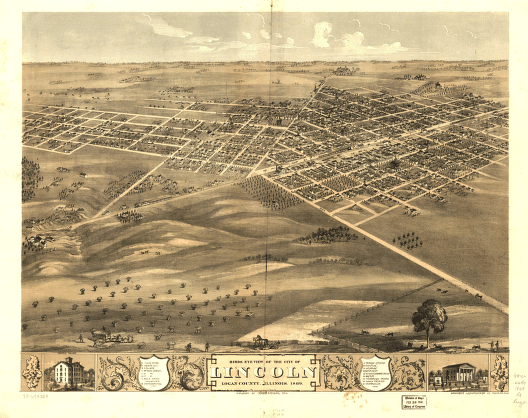
HISTORY
OF
LOGAN COUNTY, ILLINOIS
LOGAN COUNTY, ILLINOIS

This page is part of the FREE site located at http://logan.illinoisgenweb.org/. There is NO charge to access any page on this site. If you have arrived here through a pay site click here to go to the original free Logan County ILGenWeb site.

|
LOGAN COUNTY, ILLINOIS |

|

Logan County was formed February
15, 1839, from Sangamon County. [Additional parcels were added
in 1841 and 1847.] It was named after Dr. John Logan who was an
Illinois pioneer and the father of General John A. Logan. During
the 1830's and 1840's was an Illinois State Representative. Abraham
Lincoln was one of the prime movers for the formation of the new
county.

The present county seat of Logan County
is Lincoln. It was named after Abraham Lincoln in 1853 -- before
he became President. Lincoln christened the new town with juice
from a watermelon. The first county seat was Postville. In 1848
it was moved to Mt. Pulaski. In 1855, after a two year legal fight
settled by the Illinois Supreme Court, it was moved to the new
town of Lincoln, a more central location.
The first known settlers to Logan [then Sangamon] County came
in 1819 when James Latham moved north to high ground following
spring floods and, along with son Richard and Ebenezer Briggs,
made the first settlement by a spring at Elkhart. In 1820 Latham's
son in law James Chapman and his wife Betsey built a cabin at
Lake Fork on Salt Creek. Two years later the Chapman's moved along
Salt Creek to Rocky Ford. Other earliest settlers include James
Turley, John Stephenson, Aquilla Davis, Robert Musick and John
Porter.
The principal streams are Salt Creek and its tributaries Lake
Fork, Deer Creek and Kickapoo Creek and Sugar Creek. By 1823 there
were settlements at Elkhart spring, Sugar Creek, Lake Fork of
Salt Creek and Salt Creek. Later a settlement sprang up along
Kickapoo Creek. Settlement remained confined to creeks until the
railroad arrived in 1853. Early place names are associated with
the waterways or places on them such as Rocky Ford and Hurricane
Creek, both on Salt Creek.
The first school was at James Latham's home. The second was in
a stable at Robert Buckles' farm. The first actual school building
was built on Lake Fork near the farm of John Turner.
